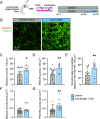The human milk component myo-inositol promotes neuronal connectivity
- PMID: 37433002
- PMCID: PMC10374161
- DOI: 10.1073/pnas.2221413120
The human milk component myo-inositol promotes neuronal connectivity
Abstract
Effects of micronutrients on brain connectivity are incompletely understood. Analyzing human milk samples across global populations, we identified the carbocyclic sugar myo-inositol as a component that promotes brain development. We determined that it is most abundant in human milk during early lactation when neuronal connections rapidly form in the infant brain. Myo-inositol promoted synapse abundance in human excitatory neurons as well as cultured rat neurons and acted in a dose-dependent manner. Mechanistically, myo-inositol enhanced the ability of neurons to respond to transsynaptic interactions that induce synapses. Effects of myo-inositol in the developing brain were tested in mice, and its dietary supplementation enlarged excitatory postsynaptic sites in the maturing cortex. Utilizing an organotypic slice culture system, we additionally determined that myo-inositol is bioactive in mature brain tissue, and treatment of organotypic slices with this carbocyclic sugar increased the number and size of postsynaptic specializations and excitatory synapse density. This study advances our understanding of the impact of human milk on the infant brain and identifies myo-inositol as a breast milk component that promotes the formation of neuronal connections.
Keywords: DHA; brain development; myo-inositol; nutritional neuroscience; synapse formation.
Conflict of interest statement
S.D.M., B.L., S.C.P., and N.P. are present and C.K. and D.H. past employees of Reckitt/Mead Johnson Nutrition. This funder performed and analyzed the human milk study. The funder had no other role in research design, data collection, and analysis and had no role in study conceptualization and result interpretation.
Figures




Comment in
-
Bridging a mechanistic gap from diet to synapses.Proc Natl Acad Sci U S A. 2023 Aug 15;120(33):e2309992120. doi: 10.1073/pnas.2309992120. Epub 2023 Aug 2. Proc Natl Acad Sci U S A. 2023. PMID: 37531376 Free PMC article. No abstract available.
Similar articles
-
Estimation of free myo-inositol in milks of various species and its source in milk of rats (Rattus norvegicus).J Dairy Sci. 1982 Apr;65(4):531-6. doi: 10.3168/jds.S0022-0302(82)82230-3. J Dairy Sci. 1982. PMID: 7096723
-
myo-Inositol metabolism during lactation and development in the rat. The prevention of lactation-induced fatty liver by dietary myo-inositol.J Nutr. 1976 Nov;106(11):1617-28. doi: 10.1093/jn/106.11.1617. J Nutr. 1976. PMID: 978267
-
Myo-Inositol Supplementation Alleviates Cisplatin-Induced Acute Kidney Injury via Inhibition of Ferroptosis.Cells. 2022 Dec 21;12(1):16. doi: 10.3390/cells12010016. Cells. 2022. PMID: 36611810 Free PMC article.
-
Myo-inositol Effects on the Developing Respiratory Neural Control System.Adv Exp Med Biol. 2018;1071:159-166. doi: 10.1007/978-3-319-91137-3_20. Adv Exp Med Biol. 2018. PMID: 30357747 Review.
-
Myo-inositol attenuates two specific behavioral effects of acute lithium in rats.Psychopharmacol Bull. 1991;27(3):185-90. Psychopharmacol Bull. 1991. PMID: 1775587 Review.
Cited by
-
Enhanced brain myelination and cognitive development in young children associated with milk fat globule membrane (MFGM) intake: a temporal cohort study.Brain Struct Funct. 2025 Apr 19;230(4):52. doi: 10.1007/s00429-025-02907-7. Brain Struct Funct. 2025. PMID: 40252122
-
Metabolic Alterations in Mothers Living with HIV and Their HIV-Exposed, Uninfected Infants.Viruses. 2024 Feb 19;16(2):313. doi: 10.3390/v16020313. Viruses. 2024. PMID: 38400088 Free PMC article.
-
A nutritional supplement taken during preconception and pregnancy influences human milk macronutrients in women with overweight/obesity and gestational diabetes mellitus.Front Nutr. 2023 Oct 17;10:1282376. doi: 10.3389/fnut.2023.1282376. eCollection 2023. Front Nutr. 2023. PMID: 37915619 Free PMC article.
-
Dietary methionine supplementation improves cognitive dysfunction associated with transsulfuration pathway upregulation in subacute aging mice.NPJ Sci Food. 2024 Dec 19;8(1):104. doi: 10.1038/s41538-024-00348-w. NPJ Sci Food. 2024. PMID: 39702349 Free PMC article.
-
Phytic Acid Maintains Peripheral Neuron Integrity and Enhances Survivability against Platinum-Induced Degeneration via Reducing Reactive Oxygen Species and Enhancing Mitochondrial Membrane Potential.ACS Chem Neurosci. 2024 Mar 20;15(6):1157-1168. doi: 10.1021/acschemneuro.3c00739. Epub 2024 Mar 6. ACS Chem Neurosci. 2024. PMID: 38445956 Free PMC article.
References
-
- Huttenlocher P. R., Synaptic density in human frontal cortex - developmental changes and effects of aging. Brain Res. 163, 195–205 (1979). - PubMed
-
- Rakić P., Bourgeois J. P., Eckenhoff M. F., Zecevic N., Goldman-Rakic P. S., Concurrent overproduction of synapses in diverse regions of the primate cerebral cortex. Science 232, 232–235 (1986). - PubMed
-
- Eidelman A. I., Schanler R. J., Breastfeeding and the use of human milk. Pediatrics 129, e827 (2012). - PubMed
-
- Horta B. L., Loret de Mola C., Victora C. G., Breastfeeding and intelligence: A systematic review and meta-analysis. Acta Paediatr. 104, 14–19 (2015). - PubMed
-
- Bode L., Raman A. S., Murch S. H., Rollins N. C., Gordon J. I., Understanding the mother-breastmilk-infant “triad”. Science 367, 1070–1072 (2020). - PubMed
Publication types
MeSH terms
Substances
LinkOut - more resources
Full Text Sources
Other Literature Sources
Medical

